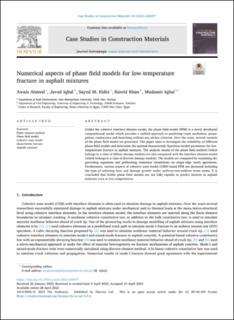| dc.contributor.author | Ahmed, Awais | |
| dc.contributor.author | Iqbal, Javed | |
| dc.contributor.author | Eldin, Sayed M. | |
| dc.contributor.author | Khan, Rawid | |
| dc.contributor.author | Iqbal, Mudassir | |
| dc.date.accessioned | 2023-10-20T11:11:23Z | |
| dc.date.available | 2023-10-20T11:11:23Z | |
| dc.date.created | 2023-05-08T09:36:04Z | |
| dc.date.issued | 2023 | |
| dc.identifier.citation | Case Studies in Construction Materials. 2023, 18 . | en_US |
| dc.identifier.issn | 2214-5095 | |
| dc.identifier.uri | https://hdl.handle.net/11250/3097771 | |
| dc.description.abstract | Unlike the cohesive interface element model, the phase field model (PFM) is a newly developed computational model which provides a unified approach to predicting crack nucleation, propagation, coalescence and branching without any ad-hoc criterion. Over the years, several variants of the phase field model are presented. This paper aims to investigate the suitability of different phase field models and determine the optimal characteristic functions/model parameters for lowtemperature fracture in asphalt mixtures. The analysis results of the phase field method (which belongs to a class of diffuse damage models) are also compared with the interface element model (which belongs to a class of discrete damage models). The models are compared by examining the governing equations and performing numerical simulations on single-edge notch specimens. Furthermore, various aspects of cohesive zone model (CZM) based PFM are discussed including the type of softening laws and damage growth under uniform/non-uniform stress states. It is concluded that brittle phase field models are not fully capable to predict fracture in asphalt mixtures even at low temperatures. | en_US |
| dc.language.iso | eng | en_US |
| dc.rights | Attribution-NonCommercial-NoDerivatives 4.0 Internasjonal | * |
| dc.rights.uri | http://creativecommons.org/licenses/by-nc-nd/4.0/deed.no | * |
| dc.title | Numerical aspects of phase field models for low-temperature fracture in asphalt mixtures | en_US |
| dc.type | Peer reviewed | en_US |
| dc.type | Journal article | en_US |
| dc.description.version | publishedVersion | en_US |
| cristin.ispublished | true | |
| cristin.fulltext | original | |
| cristin.qualitycode | 1 | |
| dc.identifier.doi | 10.1016/j.cscm.2023.e02077 | |
| dc.identifier.cristin | 2146058 | |
| dc.source.journal | Case Studies in Construction Materials | en_US |
| dc.source.volume | 18 | en_US |
| dc.source.pagenumber | 22 | en_US |

